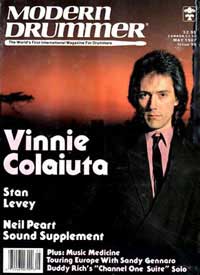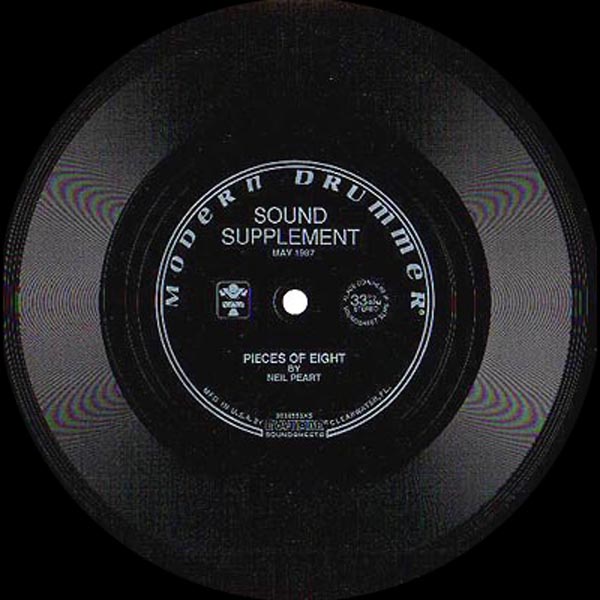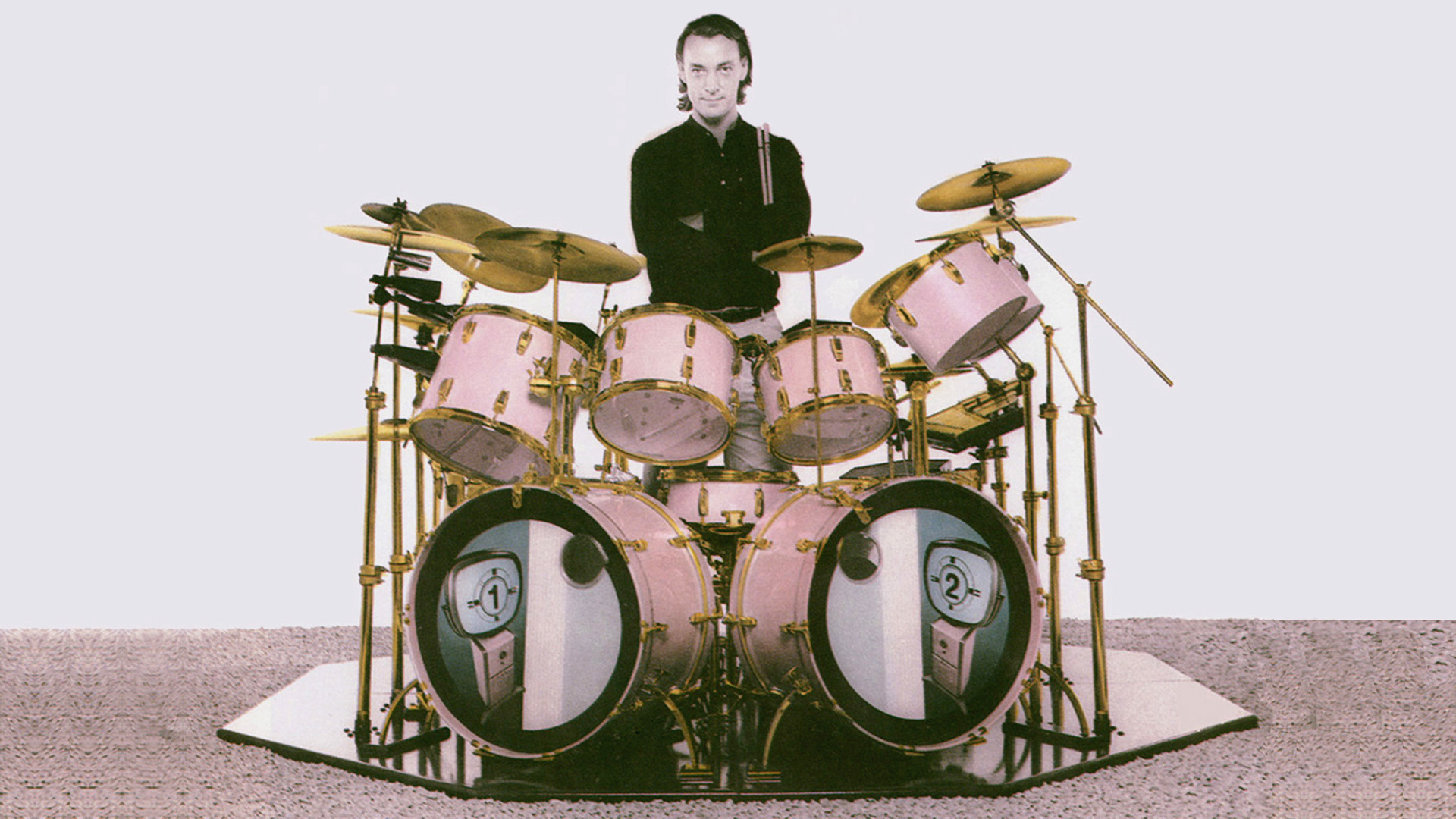The Quest for New Drums
by Neil Peart, Modern Drummer, May 1987 (included the "Pieces of Eight" flexi-disk)

Early in 1986, I started to think that it was time for a new drumkit. My red Tamas had been through four or five serious tours, and had been used in the recording of Signals, Grace Under Pressure, and Power Windows. They still sounded and looked great, but were getting a little tired, and besides, every four or five years I just like a change - perhaps a different sound and look.
But how to choose? Well, I think people usually buy what they've been satisfied with before, or they buy something that someone else sounds good playing. That's okay, I suppose, but this time I wanted to make absolutely sure that I was choosing the best-sounding drums available (or at least, the best sounding to me).
So I spoke to Neal Graham at the Percussion Center in Fort Wayne, and we arranged to have no less than six identically sized kits with the same heads brought together in the same room, so that I could do an objective "road test" of each one. We tried to pick the most resonant shells from each of the makers in which I was interested. There was a set of Tama Artstars, a set of Premier Resonators, a set of Yamaha Tour series, the new Ludwig Super Classics, a set of Sonors, and a set of Tempus fiberglass drums from Canada - what I felt would be the best drums from six countries and three continents. (Although I would certainly have included Gretsch in this category, I already have a small Gretsch practice kit at home, so I know they probably sound a bit warmer than I was looking for - plus the company proved surprisingly uncooperative in regard to this test.)
I enjoyed the long drive down to Fort Wayne from Toronto with my wife Jackie, cruising through the heartland in spring. It was lovely winding along the Maumee River in a good car, thinking thoughts of spring - and of having all those drums to play with.
But before that, I had to survive the ordeal of my first serious drum seminar(!). I had promised Neal Graham for years now that someday I would do my first real clinic for him, though the idea of speaking in front of a crowd seemed a lot more intimidating than just playing drums. But there would never be a better opportunity than this, and sometimes I like to do things that scare me! Fortunately, it went pretty well, and I felt good about having "survived" the experience.
The next day, we went out to Larry Yager's farmhouse, and I spent the whole day tuning and comparing the different kits, trying to be as objective and careful as I could. I took a walk outside once in a while to give my ears a break, as darkening skies, strengthening winds, sporadic raindrops, and weather warnings threatened my first tornado! I've always wanted to see one...I think!
But I do love to see nature in dramatic action like that, and it was nice to walk outside and be whipped by the wind for a few minutes. Refreshed and energized by these natural forces, I bravely returned indoors, and tuned and compared some more.

Playing the kits side by side, and sometimes two simultaneously, I was trying to detect the subtle differences between them. Of course, all of these are great-sounding drums; any difference I would find would have to be so subtle that only the most careful evaluation could detect it. In fact, I would have been happy to record or tour with any of these drums, but I was looking for something special - that extra bit of tonality and "snap."
While I was shopping for snap, Larry was shopping for hardware, comparing the different "shiny bits" for durability, practicality, and good design. We settled on mainly Premier stands, with a few bits and pieces from Tama and Pearl.
It was interesting that the 9x13 tom seemed to be the "acid test" for tom sounds. In each of the kits, the 8x12 and 16x16 toms were "much of a muchness," but there were subtle differences in that 9x13 that really told the tale. It seems to be a critical size.
I also checked out a few snare drums, and was particularly impressed by the new Pearl model with the interchangeable shells. Nice idea! But I'm afraid nothing has taken the place of the old Slingerland yet; it's still number one.
Another interesting discovery was that the Premier Resonators were anything but resonant! We received permission from the company to remove the inner shells, and then they sounded quite good - rather comparable to the Yamahas and Sonors in having a warm, very "controllable" sound. I'm sure any of these would make very good studio drums, for getting a good sound with a minimum of fuss.
But I was looking for something a little edgier, a little more exciting - something that needed a careful tuning and playing approach to bring it alive. And I found it, too, in the Ludwigs. The results were surprising, as I must admit Ludwig had been a kind of "dark horse" contender to me. In fact, it was a very near thing between them and the Tamas. I had to take another walk outside, and then compare them again to be sure. (Disappoint- ingly, but perhaps fortunately after all, the tornado failed to appear!)
But there is was: the response, the tonality - the overall excitement of the Ludwig sound was just fractionally better. So...I ordered a set!
We were to start working on new material in the fall, and I really wanted to update my electronic outfit as well. I had been watching the progress of digital sampling units for a couple of years, and felt that the time was right to explore that. I spoke with the band's "technological mentor," Jim Burgess, told him what I was after, and he recommended that Akai unit, with a Yamaha MIDI controller. I decided to stay with the latest Simmons pads, as I like the feel of them.
The sounds are digitally stored on those little 3 1/2" computer disks, and once you put them into the Akai's RAM memory, you can edit and change them at will without affecting the original sample. Assigning them to different pads is a simple affair, and you can copy from the RAM to a new disk to create new setups and safety copies. With the Yamaha MIDI controller, you can create "chains," which allow you to change programs with the flick of a footswitch. For example, in one of the new songs on which we're working as I write, I play an African drum setup for the verses, and then "click" to a setup of my acoustic Tama drums, sampled from "Grand Designs", for the choruses. Fantastic! I love it!
I have mentioned before in MD's pages that I do not have a natural empathy with technological things - they often give me a headache - but at the same time I had to get into this, because, in the simplest terms, it does what I want! I have an insatiable hunger for new percussion sounds, but there is just no room in my existing setup for any more drums! This way, I can have access to every percussion sound ever played (and some beyond), and still be able to reach them all!
I spent some time with Jim assembling a library of disks: all kinds of ethnic percussion, acoustic drum samples from our Power Windows album paint cans, big sheets of metal, industrial sounds, pipes being struck - you name it! The possibilities are absolutely infinite.
One more decision that had to be made was whether or not to have the Vibrafibing applied to the inner shells. My last three kits had been treated by the Percussion Center with this thin layer of fiberglass, which is meant to even out the tonality. In keeping with my policy this time of taking nothing for granted, I asked them to do a sample 9x13 Ludwig tom to compare with an untreated one. Once again, it was a painstaking decision; I even took them into "Le Studio" to listen to, since I was in Quebec at the time. I found them to be a little sharper with the Vibrafibing, and the tonality was a little more focused.

Making a decision on the finish was equally difficult. As much as I loved the Candy Apple Red finish of my Tamas, I just couldn't have the same color again! Neal and I discussed a few possibilities, and he did me up a sample with a mix consisting of an opalescent white base, with just a hint of pink in it, and a few metallic flecks to highlight the opalescence. (More goodies from the "hot rod" finishes book!) I stayed with the brass plating on the hardware - because I couldn't think of anything nicer!
Another thing I have been seeking for quite a while is a keyboard percussion synthesizer. I had been playing a marimba quite a lot and really wanted some kind of more portable instrument to use live and (hopefully) in the studio. Once again, Jim did some research and came up with a unit made by the KAT company in Massachusetts.
It is available in modules of one octave and up, and basically consists of a set of soft rubber pads laid out as a keyboard. I decided on a three- octave range, and since the KAT is also a programmable MIDI controller, compatible with the Akai unit, I started collecting samples of marimbas, vibes, tubular bells, glockenspiel, tuned African percussion, harp arpeggios - again, you name it!
Like many percussionists, I had long harbored a secret wish to create a piece of music using only percussion instruments, and this looked like the key to that dream! I practiced with the KAT for a few days and then, when I had a free day, recorded a "demo" of a marimba piece I had been working on over the summer.
I began with the marimba part, double-tracked it, and then overdubbed my acoustic drums on top (yes, the new Ludwigs!). I began experimenting with overdubbing different vibe sounds, a bass marimba, a cabasa, castanets, concert toms, metal sheets, African toms, and some highly tuned bongos. (All of this was played with mallets on the KAT unit.) I did use one of Geddy's keyboard sounds, but since it consisted of a marimba with a human voice mixed in, I decided that was close enough!
The biggest difficulty was finding a good bass instrument in the percussion library. The bass marimba didn't provide the power in the bottom end that I was looking for, so we experimented with some other things. We ended up using an African drum called a Djembe - transposed to the keyboard - and I played the bass part with that! It made me laugh - a new definition of "bass drum"!
The piece is entitled "Pieces Of Eight" because of all the different time signatures it ended up meandering through. I hadn't thought about that too much just playing the marimba, until I had to learn it on drums! With only a day to record it all, I didn't really have time to play it more than a couple of times through, so that, too, was a good challenge.
I find it interesting as a drummer to work with a melodic instrument and think melody as well as rhythm. You can really get into some wild areas! In a way, I wish I hadn't been so obsessed with drums alone in the beginning and had acquired more knowledge of music theory. But I suppose in this day and age you do have to specialize!
Now, if I only had about two weeks in the studio to work on this thing...
So I've got my new drumkit. Am I happy now? Well, yeah! Here I've managed to hang on to the best of both worlds: an exciting-sounding acoustic set and an incredibly versatile and "user-friendly" electronic set. Who could ask for more?
Well, how about "Pieces Of Eight" becoming a hit single? Ha-ha!
Credits
Recorded and mixed at Elora Sound Studios
Engineered by Jon Erickson
Technical Assistance by Jim Burgess, Larry Allen, and Tony Geranios
Copyright 1987 by Neil Peart